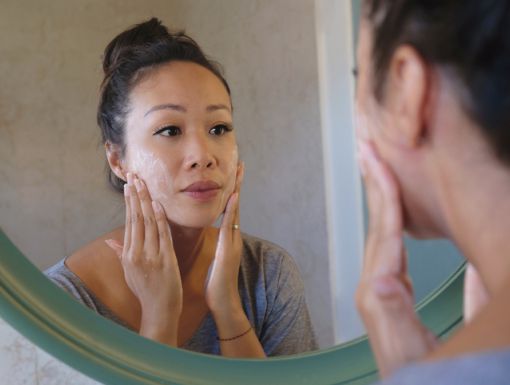
Here's Why Pore Strips Are a Bad Idea for Your Skin
If you’ve been on social media lately, like most of us, you’ve probably seen videos of dermatologists giving pros and cons of skin care products. Specifically, videos of pore strips have become popular and are oddly satisfying to watch. There are mixed reviews on whether the strips remove debris accumulating within pores or if the strong adhesives irritate the skin and yank away more than just blackheads.
What causes acne?
Acne is a common inflammatory skin condition that happens when hair follicles under the skin become clogged. We have a mixture of oils, cells and bacteria on our faces, which can get into the hair follicles, causing irritation, swelling, redness, heat and pain, and lesions or pimples. Acne can also flare up due to hormone changes, which are most common in teenagers and young adults. For most people, acne tends to go away once they reach their thirties, but some people in their forties and fifties continue to have this skin problem.
In some cases, dermatologists may recommend extractions, prescriptions or a new skin care regimen to help clear your skin over time. There are several types of acne that you may experience:
- Whiteheads: Form when excess oil and dead skin cells build up and plug the opening of a pore. This causes a blemish that is raised and produces a white bump. Dermatologists recommend treating these with an acne treatment versus picking at them.
- Blackheads: A blackhead doesn’t suggest that your face is dirty. This acne develops when excess oil and dead skin cells build up inside a pore. The plugged follicles that reach the skin surface open up and look black on the skin surface.
- Papules: Inflamed lesions that usually appear as small, pink bumps on the skin and can be tender to the touch.
- Pustules: Small bumps on the skin that contain fluid or pus. They usually appear as white bumps surrounded by red skin.
- Nodules: Large, painful, solid lesions that are lodged deep within the skin.
- Cystic acne: Severe type of acne in which the pores in the skin become blocked, leading to infection and inflammation.
What are pore strips?
Pore strips have become a popular skincare fad on the internet. People share videos of themselves using the strips at home, which can be gross but oddly satisfying. There are claims that the strips extract and remove blackheads without damaging your skin, but is that true?
Pore strips are woven with adhesives that, when wet, attach to the nose and are left on for five to 10 minutes until they dry out. When pulled off, you’ll find oil from your skin, dead skin cells, hair, bacteria or dirt on the strip. Some pore strips even contain Polyquaternium 37, which is used in hair sprays to help set hair. Now, imagine using that on your face.
While the occasional use of a pore strip is Ok, if you’re looking for a deep cleansing of the face, these strips are not the best product and should not be used regularly because it can cause irritation on your skin. When pulling up the pore strips, you can pull up parts of your epidermal layer. This layer is vital to protecting your skin against bacteria and irritations from the outside world and helps prevent water loss from your skin. Your risk of skin infections, irritations and dryness can increase when you remove this layer. Removing the pore strips can also cause capillaries, or small blood vessels, in your nose to break and become more visible. Also, if you have psoriasis, eczema or active acne, using pore strips can be dangerous for your skin and compromise your skin barrier. Your skin can then become dry, causing more acne and eczema flare-ups.
Although your skin may feel cleaner and smoother, pore strips also don’t help your skin from developing blackheads. Over time, the strips can pull and stretch your pores, which can make them more prominent and visible. Soon your blackheads may increase and become worse.
What are alternatives to pore strips?
Pore strips are fun to use sometimes, but there are better alternatives to keep your beauty long-lasting.
According to the American Academy of Dermatology, you can make your pores less noticeable in several ways. Having a regular skincare routine is the first step. You should wash your face twice daily with warm water and a cleanser that won’t irritate your skin. Consider using salicylic acid twice weekly, as it is an anti-inflammatory agent that promotes exfoliation. Using strips over a long period of time is also not as effective as using retinoids, retinols and chemical peels. Talk to your dermatologist first before using these options.
Sun damage can also emphasize pores, so apply a broad-spectrum sunscreen with at least SPF 30 daily. Finally, if you wear makeup, choose products that say “noncomedogenic,” “oil-free,” or “won’t clog pores.” These formulas won’t settle into or emphasize your pores.
The verdict
Pore strips are safe to use occasionally, but they can cause trauma to the skin with excessive pulling. Using pore strips responsibly is essential. It is recommended not to use them more than once a week, and you want to ensure that your skin is clean before using them. Follow the directions, and don’t leave the strip on longer than the suggested time. Be sure to remove any adhesive left on your face to prevent irritation and cleanse your face afterward. If you have allergies to certain cosmetic products, be cautious and do a small test spot before placing them on your face.
The next time you’re shopping for pore strips, consider your skin and the damage they may cause. Stick with other safer, less sticky methods to get that deep cleaning sensation and better results.
Schedule an appointment with an Ochsner dermatologist today.

